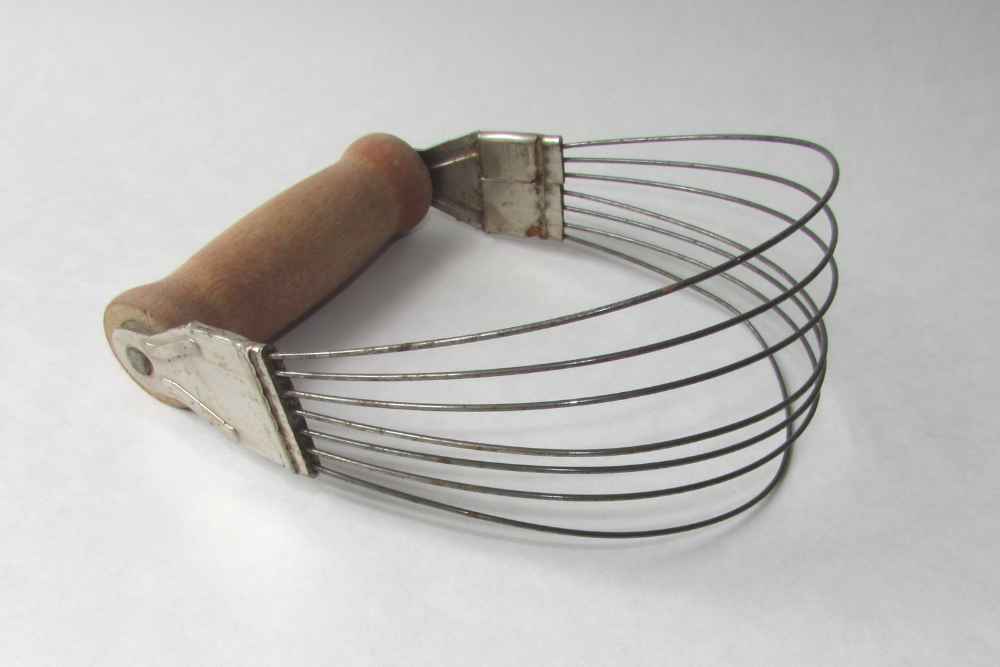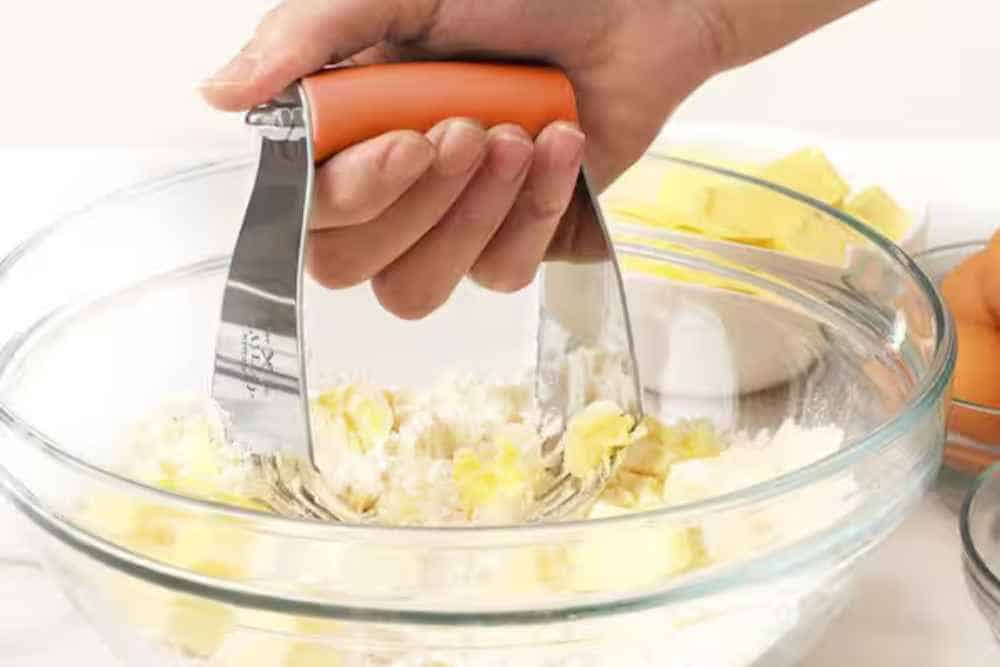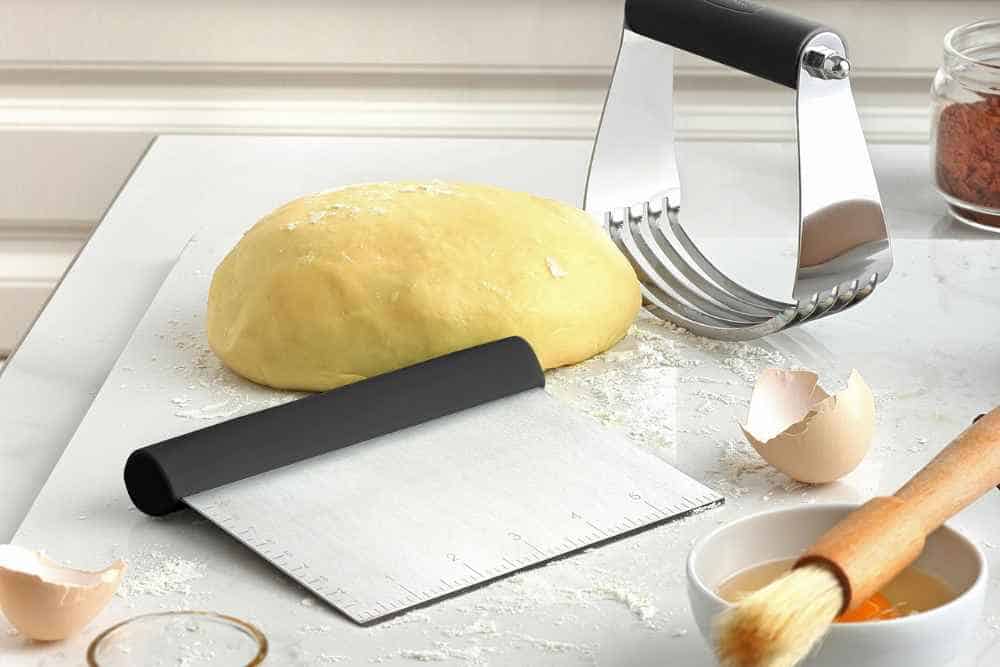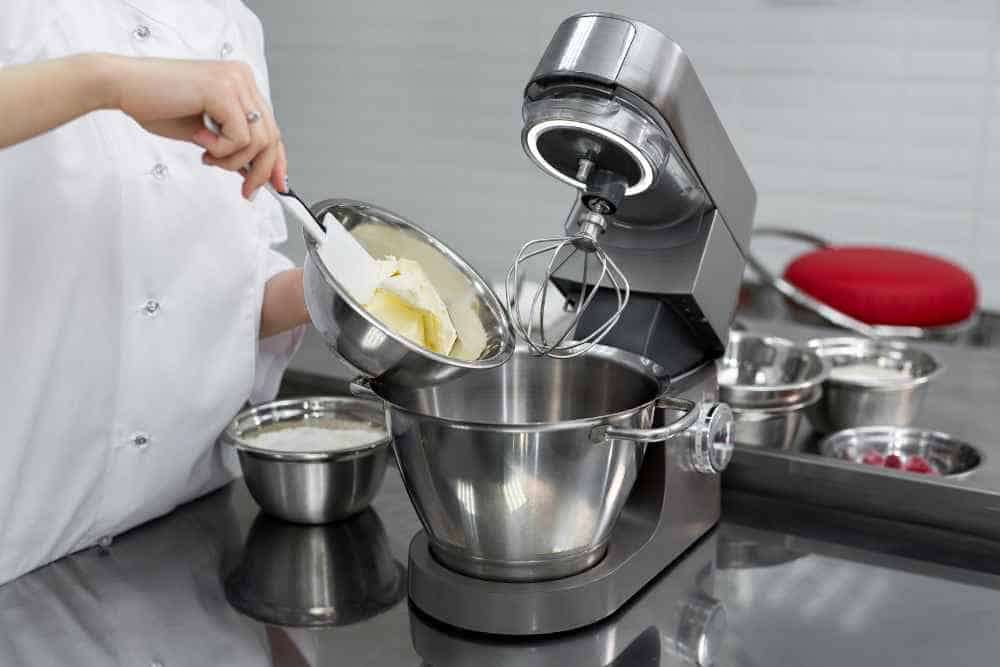What is a pastry blender, you ask? Well, imagine this handy tool as your secret weapon in the kitchen, especially when it comes to baking delicious treats like pies, biscuits, and scones. So, here’s the deal: when we’re making pastry dough, mixing the butter or shortening into the flour can be a bit of a challenge. It’s like trying to blend two different worlds together – dry flour and cold fats – and getting them to cooperate. That’s where the pastry blender swoops in to save the day! And hey, if you’re looking to invest in versatile kitchen tools, remember that some blenders aren’t just for smoothies – there are blenders for cooking, too, ready to tackle tasks beyond your imagination!
Without a pastry blender, we might resort to using our hands or forks to blend the butter into the flour, but it’s messy and doesn’t always result in the perfect texture. Sometimes, the butter gets too warm, and the dough ends up tough instead of flaky. But fear not! The solution lies in the trusty pastry blender. With its sturdy wires or blades, the pastry blender effortlessly cuts through the cold butter or shortening, evenly distributing it throughout the flour mixture. And don’t worry if you don’t have one of those fancy, expensive pastry blenders – even cheep blenders can do the job just fine!
The result? Perfectly crumbly, flaky pastry dough that’s ready to be shaped and baked into delicious treats. So, if you’re serious about your baking game, a pastry blender is a must-have tool in your kitchen arsenal!
Pastry Blender – Description
Well, a pastry blender is a handy kitchen tool designed to mix butter or shortening evenly into flour when making pastry dough. It typically consists of a handle attached to several sturdy wires or blades, which help cut the fats into the dry ingredients, creating a crumbly texture ideal for baked goods like pies, biscuits, and scones. With its efficient design, the pastry blender simplifies the process of blending ingredients, ensuring consistent results and deliciously flaky pastries every time.
Purpose And Functionality
When it comes to understanding the purpose and functionality of a pastry blender, let’s delve into the heart of this essential kitchen tool:
Blending Butter and Flour:
At its core, the primary purpose of a pastry blender is to seamlessly blend cold fats, such as butter or shortening, into dry ingredients like flour. This process is crucial when making pastry dough for various baked goods, as it creates a crumbly texture that is essential for achieving flaky, tender pastries.
Ensuring Even Distribution:
The functionality of a pastry blender lies in its ability to evenly distribute the fats throughout the flour mixture. The blades or wires of the pastry blender cut through the cold fats, breaking them into smaller pieces and incorporating them into the flour. This ensures that every particle of flour is coated with fat, resulting in a uniform texture and consistency in the dough.
Creating Flaky Texture:
By efficiently blending the fats into the flour, a pastry blender helps create the desired flaky texture in pastry dough. The small chunks of cold fat dispersed throughout the dough create layers during baking, which puff up and separate, resulting in a light and airy pastry crust that is both tender and delicious.
Promoting Consistent Results:
One of the key benefits of using a pastry blender is its ability to promote consistent results in baking. Unlike manual methods such as using hands or forks, which can lead to uneven mixing and inconsistent texture, a pastry blender ensures that the fats are evenly distributed throughout the dough, leading to uniformity in the final baked product.
Versatility in Baking:
Beyond its primary function in making pastry dough, a pastry blender can also be used for other baking tasks. It can be used to mix ingredients for crumb toppings, incorporate fats into biscuit or scone dough, or even cut butter into flour for streusel or crumble toppings. Its versatility makes it a valuable tool for various baking projects in the kitchen.
Types Of Pastry Blenders
When it comes to pastry blenders, there are several types available, each offering unique features and benefits suited to different preferences and baking needs:
Traditional Pastry Blender

This classic pastry blender features a handle attached to sturdy wires or blades. It’s manually operated, requiring users to press and rotate the blender through the flour mixture to blend fats evenly. This type offers simplicity and reliability, making it a popular choice among home bakers.
Dough Blender with Blades

This variation of the pastry blender replaces wires with blades made of stainless steel or other durable materials. The blades provide a more efficient cutting action, making it easier to blend cold fats into flour quickly and evenly. Ideal for heavy-duty mixing tasks and larger batches of dough, it’s a favorite among bakers seeking efficiency.
Pastry Cutter with Comfort Grip Handle

Similar to traditional pastry blenders, this type features an ergonomic handle for added comfort and ease of use. Designed to reduce hand fatigue during prolonged use, it’s suitable for frequent bakers or those with hand strength issues, offering both practicality and comfort.
Multi-Blade Pastry Blender

Featuring multiple blades or wires arranged in a grid pattern, this pastry blender offers enhanced cutting and blending efficiency. It provides a more thorough mixing action, reducing the time and effort required to achieve the desired texture in pastry dough. Perfect for professional bakers or those handling large quantities of dough regularly.
Pastry Blender with Built-in Scraper

This innovative design incorporates a built-in scraper or spatula along with the blades, allowing users to easily scrape off excess dough and ingredients. This feature helps minimize waste and cleanup time, promoting a more efficient and hygienic baking process. It’s ideal for precision mixing and scraping tasks, especially when working with sticky or delicate doughs.
Electric Pastry Blender

Operated by an electric motor, this type automates the blending process, eliminating the need for manual effort. It offers hands-free operation and consistent results, making it suitable for busy kitchens or professional baking environments. Available in various sizes and power capacities, it accommodates different baking needs and preferences with ease.
How To Use A Pastry Blender?
Using a pastry blender is quite straightforward and can significantly simplify the process of making pastry dough. Here’s a simple guide on how to use a pastry blender effectively:
Prepare Your Ingredients
Start by gathering all the ingredients required for your pastry dough, including flour and cold fats such as butter or shortening. Ensure that your fats are chilled before using them, as cold fats are essential for achieving a flaky texture in the dough.
Cut Fats into Flour
Add the flour to a mixing bowl and then add the chilled fats, either diced or cut into small cubes. Using your pastry blender, press down firmly into the mixture, cutting through the fats and blending them into the flour. Continue this motion until the fats are evenly distributed throughout the flour and the mixture resembles coarse crumbs.
Incorporate Liquid Ingredients
Once the fats are blended into the flour, you can add any liquid ingredients called for in your recipe, such as water, milk, or eggs. Use a spatula or wooden spoon to gently mix the liquid into the flour mixture until a dough forms. Be careful not to overmix, as this can result in a tough dough.
Knead and Shape the Dough
Once the dough comes together, transfer it to a lightly floured surface and knead it gently until it forms a smooth, cohesive ball. Depending on your recipe, you may need to let the dough rest or chill it before shaping or rolling it out for baking.
Clean and Store the Pastry Blender
After using the pastry blender, be sure to clean it thoroughly with warm, soapy water and dry it completely before storing it. Proper maintenance will ensure the longevity of your pastry blender and keep it ready for future baking adventures.
Benefits Of Using A Pastry Blender
Using a pastry blender offers several benefits that can simplify the process of making pastry dough and enhance the quality of your baked goods. Here are some key advantages of using a pastry blender:
Efficient Mixing
A pastry blender efficiently blends cold fats, such as butter or shortening, into flour, ensuring even distribution throughout the dough. This results in a uniform texture and consistency, minimizing the risk of overmixing or uneven incorporation of ingredients.
Flaky Texture
By cutting the fats into small pieces and blending them into the flour, a pastry blender helps create a flaky texture in pastry dough. The small chunks of fat dispersed throughout the dough create layers during baking, resulting in light, airy pastries with a tender crumb.
Consistent Results
Using a pastry blender promotes consistency in baking by ensuring uniform mixing of ingredients. This helps achieve consistent results each time you bake, whether you’re making pies, biscuits, scones, or other pastries, leading to reliably delicious treats.
Time-Saving
Pastry blenders streamline the mixing process, allowing you to blend fats into flour quickly and efficiently. This saves time and effort compared to manual methods such as using hands or forks, especially when working with larger batches of dough.
Versatility
Pastry blenders are versatile tools that can be used for a variety of baking tasks beyond mixing pastry dough. They can also be used to mix ingredients for crumb toppings, incorporate fats into biscuit or scone dough, or cut butter into flour for streusel or crumble toppings.
Ease of Use
With its simple design and ergonomic handle, a pastry blender is easy to use and maneuver, making it suitable for bakers of all skill levels. Whether you’re a beginner or an experienced baker, a pastry blender can help simplify the baking process and produce professional-quality results.
Common Mistakes To Avoid
When using a pastry blender, it’s important to be aware of common mistakes that can affect the quality of your pastry dough. Here are some pitfalls to avoid:
Overworking the Dough
One of the most common mistakes is overmixing the dough with the pastry blender. This can lead to tough, dense pastries instead of light and flaky ones. Avoid excessive mixing and stop as soon as the fats are evenly distributed and the dough comes together.
Using Warm Fats
Using fats that are too warm can result in greasy, oily dough that lacks structure. Make sure your butter or shortening is cold and firm before blending it into the flour. Chilled fats are essential for achieving the desired flakiness in pastry dough.
Not Measuring Ingredients Accurately
Baking is a science, and accurate measurement of ingredients is crucial for success. Use measuring cups and spoons to measure flour, fats, and other ingredients precisely according to your recipe. Inconsistent measurements can lead to variations in texture and baking results.
Neglecting to Chill the Dough
After mixing the pastry dough, it’s important to chill it before shaping or rolling it out. This allows the fats to firm up again, making the dough easier to work with and preventing it from becoming too sticky. Skipping this step can result in difficult-to-handle dough and tough baked goods.
Using the Wrong Type of Flour
Different types of flour have different protein contents, which can affect the texture of your pastry dough. Using all-purpose flour is generally suitable for most pastry recipes, but be cautious when substituting with other types of flour, as they may yield different results.
Ignoring Visual and Textural Cues
Pay attention to the texture and appearance of the pastry dough as you mix it with the blender. Stop mixing as soon as the fats are evenly distributed and the dough holds together when pressed. Overmixing can lead to tough, dense pastries, so trust your instincts and stop mixing when the dough looks right.
Maintenance And Care Tips
Proper maintenance and care of your pastry blender are essential for ensuring its longevity and optimal performance. Here are some helpful tips to keep your pastry blender in top condition:
Clean After Each Use
After using your pastry blender, wash it thoroughly with warm, soapy water to remove any dough or residue. Use a brush or sponge to clean between the wires or blades, ensuring no dough is left behind. Rinse the blender thoroughly and dry it completely before storing.
Avoid Dishwasher Use
While some pastry blenders may be dishwasher-safe, hand washing is generally recommended to prolong their lifespan. The harsh detergents and high heat of the dishwasher can cause damage to the blades or handle over time. Hand washing with mild soap and water is gentler on the blender.
Dry Thoroughly Before Storage
After washing, make sure to dry the pastry blender completely before storing it. Moisture left on the blades or handle can lead to rust or corrosion, compromising the integrity of the blender. Use a clean dish towel or air dry the blender in a well-ventilated area before storing it.
Store Properly
Store your pastry blender in a dry, well-ventilated area away from direct heat or sunlight. Avoid storing it in damp or humid conditions, as this can promote rust or corrosion. If possible, store the blender in a drawer or utensil holder to protect it from damage and keep it easily accessible.
Inspect Regularly
Periodically inspect your pastry blender for any signs of damage or wear, such as bent wires or loose handles. If you notice any issues, discontinue use and replace the blender if necessary. Regular maintenance and prompt repairs can help prolong the life of your pastry blender and ensure safe and effective use.
Avoid Using on Hard Surfaces
When using your pastry blender, avoid using it on hard surfaces such as countertops or cutting boards. Instead, use it in a mixing bowl or on a flexible cutting mat to prevent damage to the blades or handle. This will help preserve the integrity of the blender and prevent premature wear and tear.
Conclusion
In conclusion, the pastry blender emerges as an indispensable ally in the kitchen, simplifying the process of blending fats into flour to create flaky and tender pastry dough. With its efficient functionality and versatility, it ensures consistent results and enhances the quality of baked goods, making it a must-have tool for both novice and experienced bakers alike.
Whether you’re whipping up pies, biscuits, or scones, the pastry blender proves to be a reliable companion, unlocking endless possibilities in the realm of baking. So, if you’re ready to elevate your pastry-making game and delight your taste buds, adding a pastry blender to your kitchen toolkit is a decision you won’t regret.
FAQs
What Does A Pastry Blender Do?
A pastry blender efficiently mixes cold fats into flour to create a crumbly texture for pastry dough.
What Can I Use Instead Of A Pastry Blender?
Instead of a pastry blender, you can use two knives, a fork, or your fingertips to cut fats into flour.
Is A Pastry Blender Necessary?
While not absolutely necessary, a pastry blender greatly simplifies the process of making pastry dough and ensures consistent results, making it a valuable tool for baking enthusiasts.






